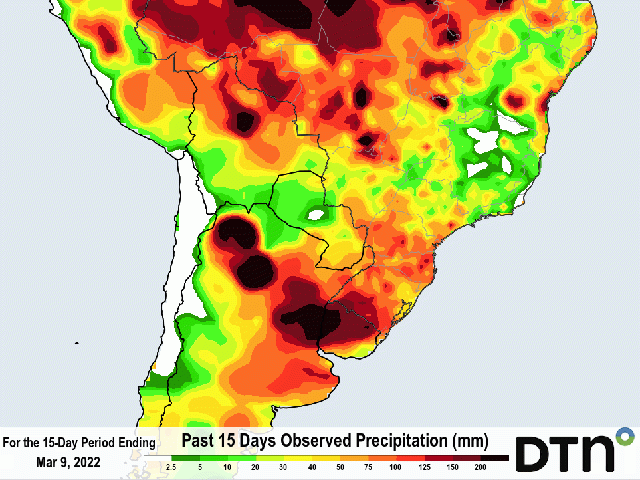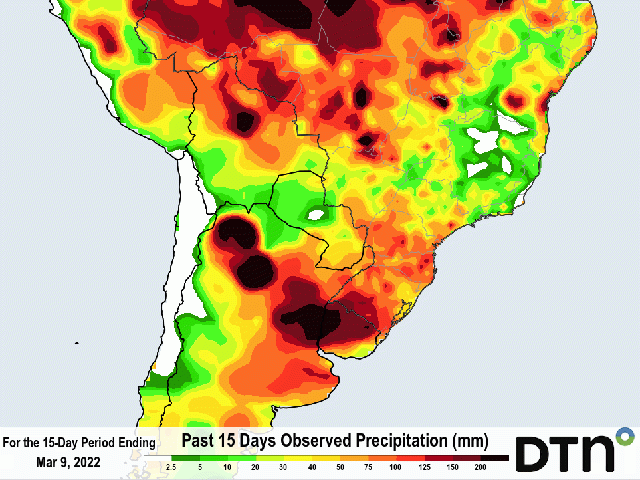South America Calling
Rainy Period Coming to an End in South America
The last two weeks-worth of precipitation has been somewhat of a "Hail Mary" type of situation for crop conditions in Argentina and southern Brazil.
Dryness and drought have plagued corn and soybeans all season long. Early planted corn and soybeans in Argentina and first-crop soybeans in southern Brazil have already had their fate sealed due to the hot and dry conditions this spring and summer. But rainfall could still save the later-planted corn and soybeans in Argentina and the safrinha (second-crop) corn in southern Brazil. A period of rain in mid-late January had seemingly little effect on crop conditions in both countries and both private and government estimations of production have been cut during the last two months. A rainy period was just what these areas needed and received. But did it make a difference?
Rainfall amounts during the last two weeks are estimated in the 30 to 100 millimeter (1.2 to 4 inches) in southern Brazil, but 50 to 200 mm (2 to 8 inches) in Argentina. But that rainfall is coming to an end.
On the report issued by the Buenos Aires Grain Exchange on Mar. 10, crop conditions in Argentina did increase for both corn and soybeans. However, the improvements were mostly miniscule.
P[L1] D[0x0] M[300x250] OOP[F] ADUNIT[] T[]
Good-to-excellent ratings for corn increased from 21% last week to 25% this week. For soybeans, the increase was from 25% last week to 30% this week. Poor-to-very poor ratings for both were lower at 23% for corn and 20% for soybeans. Both were reductions as well, from 26% and 25%, respectively. So, while neither crop is doing great, most of the crop is at least in fair condition. And in both cases, crop conditions to date are better than they were last year.
In Brazil, the rains have kept up with early demand for newly planted safrinha corn. Reports from the Department of Rural Economics in the state of Parana note that, as of Mar. 7, corn is only 69% planted. However, ratings on the early corn are at 90% good to excellent. Ratings this early in the crop cycle can be dubious, but the corn is starting off in better shape.
However, AgRural estimates that safrinha corn is only 81% planted in Brazil. There is a lot of season left to go. And one good rainy period is not going to carry through the entire growth cycle, especially when temperatures regularly exceed 30 degrees Celsius (86 Fahrenheit) on a daily basis all the way through the remainder of the growing season. The forecast from here on out will need to be monitored for any signs of further dryness, or an abrupt end to the wet season across central areas.
Unfortunately for producers, dryness is indeed in the forecast. A front is pushing north of Argentina on March 10 and has cleared precipitation out of most of the country. The front will take some time, but it will do the same to southern Brazil and from Mato Grosso do Sul and Sao Paulo southward, showers will become largely absent after March 13. Models do indicate a fast-moving front at the end of next week, but showers would be brief. Longer-range models also have increased precipitation in southern Brazil for the last few days of March. But April is looking to continue dryness.
For Argentina, the current soil moisture may be the highest it is going to get for the majority of the corn that is filling grain, and the large portion of soybeans flowering and filling.
In Brazil, southern states have a chance of picking up more moisture during the next few weeks, but on-the-whole the region is looking at below-normal precipitation.
We will have to see if it is enough to finish out the crop. Central states rely on a timely end to the wet season, which abruptly comes at the beginning of May on average. La Nina tends to shorten the wet season by a week or two. Looking ahead on long-range models, they are noting drier conditions at the end of April. Rainfall during the next few weeks is going to be important, so that corn can make it to grain fill before the rains shut down.
Wetness lately has been somewhat positive in South America, but it will not be enough to turn around crops in Argentina or sustain the new safrinha corn crop in Brazil.
To find more international weather conditions and your local forecast from DTN, head over to https://www.dtnpf.com/…
John Baranick can be reached at john.baranick@dtn.com
(c) Copyright 2022 DTN, LLC. All rights reserved.






Comments
To comment, please Log In or Join our Community .